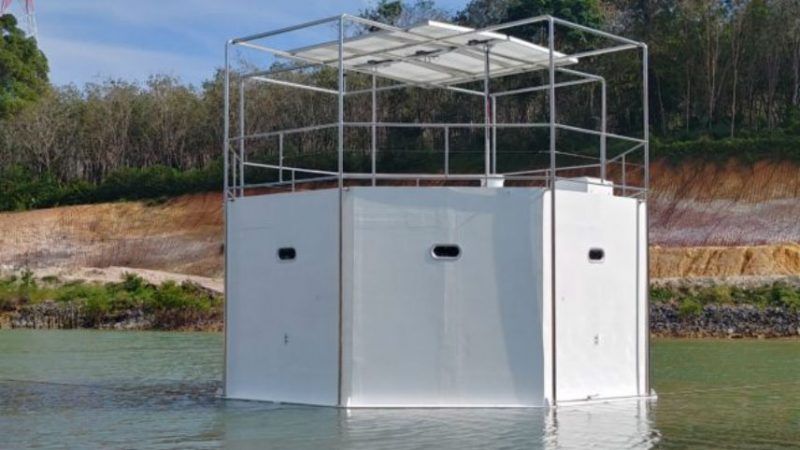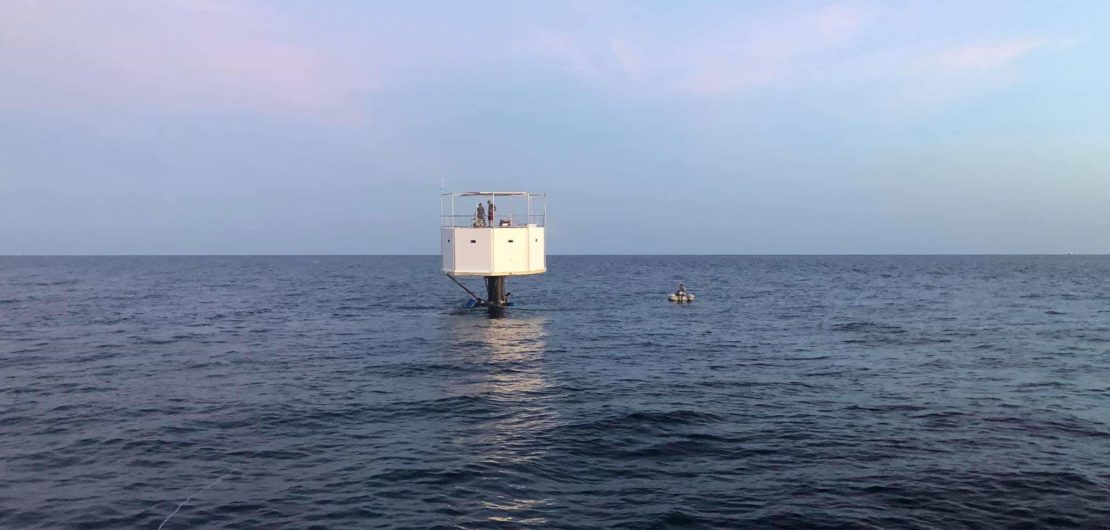First Seastead in International Waters Now Occupied, Thanks to Bitcoin Wealth
Two libertarians now have a private home off the coast of Thailand-proof of concept for a world of more competitive governance and greater ocean environmental health.

Seasteading was conceived more than a decade ago out of libertarian enthusiasm for the possibilities of improving governance through an explosive proliferation of new polities. Building modular floating "land" on the high seas, its advocates argue, would increase our ability to escape the depredations of existing governments.

In a short video documentary that debuted last night—part one of a four-part series that will be rolled out over the next week—Seasteading Institute president Joe Quirk (co-author of the book Seasteading: How Floating Nations Will Restore the Environment, Enrich the Poor, Cure the Sick, and Liberate Humanity from Politicians) tells the story of the first functional one-family seastead, which now exists 12 nautical miles off the coast of Phuket, Thailand.
Its inhabitants are Chad Elwartowski and Nadia Summergirl. In a chat-window interview before the video premiered on YouTube last night, Elwartowski told me that his "main motivation has been finding true liberty in this lifetime. I have participated in several other projects that promised that but never delivered," including the "?Free State Project, Libertarian Party elections, Ron Paul campaign, other seastead projects."
Now he's living in a private seastead in international waters along with Thai native Summergirl, who says in the video that she was tired after 10 years of seeing seasteading remain just talk: "I just want to get seasteading happen for real. I want to make it happen here in Thailand." The team surrounding the project were early adopters of bitcoin, and with wealth acquired that way it has spent around $150,000 on the project, Elwartowski says. That's about $30,000 more than they anticipated—"as it is experimental we ended up adding and adding and adding," he tells me. (I wrote speculatively about bitcoin wealth funding libertarian projects last year, before this project was public.)
The seastead has been floating since February 2. "We've been about a week on, week off as we take care of things on land," Elwartowski tells me via email. "This past week we bought a sail boat and we're having the bottom painted so we have a commuter boat. After that we should be there full time. Except for going to visit the many islands around us."
Though the seastead is a mere 6-meter-wide, two-story octagon, Elwartowski says: "Tightness has never been an issue for us. We lived in a small bungalow in Tahiti. I lived in a small box for 2 years in Afghanistan. There is plenty of room. Nadia likes to fish while I'm either working on the seastead down below or on the computer in the bedroom."
Their octagon sits atop a floating spar ballasted with concrete and sand, 20 meters long, 2 meters in diameter, and 14mm thick. According to the website of the venture that builds and places it, going under the name Ocean Builders (which used mostly local Thai labor), "The seastead is able to withstand 5 meter waves but will be sitting in the Andaman Sea where the average wave height is half a meter."
They have not bothered trying to make deals with the government of Thailand, Elwartowski says: "We have been keeping under the radar so far but we follow all the laws of Thailand so it's as if we're just living on a boat in the water as far as they're concerned….All we expect from the Thai government is that they follow international law. We will be doing the same. But Nadia and I aren't doing anything we can't do on land."
The Seasteading Institute is not directly involved in Elwartowski and Summergirl's seastead, aside from Quirk documenting and spreading its story in his role as "seavangelist." But Quirk tells me he's more than thrilled to see an actual seastead in existence. The concept's last big hurrah was an agreement with French Polynesia to build a seastead, a project that for now at least is dormant.
Elwartowski and Summergirl had been "living on the atoll" there where they hoped they'd built the first seastead. When that project halted, they moved to Thailand to do it themselves.
"It seems like the Seasteading global movement has become robust, anti-fragile," Quirk says. "Every time [the concept] takes a hit, it goes faster! We felt we were being audacious" with their claim in the French Polynesia deal that "we'd get the first seastead built by 2020. But because of the setback in French Polynesia, which I hope is temporary, Chad and Nadia got a seastead in 2019."
The world of people interesting in making seasteads is still small. When Quirk learned of Ocean Builders' plans, mere months ago, and came out to Thailand to check it out with a camera crew, he found a dozen volunteers helping out who he already knew from his years of promoting the idea.
He's wonderfully surprised to learn that seasteaders' fears that going straight to international waters might be too expensive, or require something as built out as an oil rig, seem to have been wrong. He's also impressed that an angle he pushed in his book—the idea that seasteads can be meaningful nexuses of oceatic environmental health—is being furthered by Elwartowski and his team, who are experimenting with growing edible seaweed and encouraging the growth of coral around their seastead spar.
"The idea of seasteading being environmentally restorative and increasing the amount of life in the world" will start with this very first seastead, Quirk believes. On Ocean Builders blog, Elwartowski writes that "fish have really taken to hanging out around the seastead. They love it. Previously we would visit the site to do some surveys of various things at that location and we hardly saw any fish out there. Now it like a fish sanctuary. We see dolphins and tuna around our seastead all the time. It is my theory that this small place is the only place the vast amount of Thai fishing boats cannot go to so they thrive here as opposed to in the open water where the fishing nets may sweep them up."
The documentary's first installment is mostly dedicated to some of the political ideas that animate the inhabitants and other seasteading-world volunteers, plus some hints of the physical challenges of setting their spar in place at sea, which will be explored further as the video series continues over the next week. More details can also be found on the website of Ocean Builders, which is trying to sell seasteads to others to form an active seasteader community around Chad and Nadia. Their ocean home wound up being cheaper than most houses in the United States.
Part one of Quirk's video documentary, Facing the Storm, is embedded below. The next three parts, rolling out over the next week, will be titled Raising the Spar, Lifting the 'Stead, and Living the Life. Chad and Nadia and their team will be running training courses in seasteading techniques in the spring.

Show Comments (59)